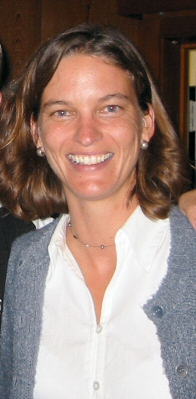The Advanced Photon Source (APS) Users Organization is pleased to announce that Dr. Alexis S. Templeton has been chosen to receive the first APS Rosalind Franklin Young Investigator Award. Dr. Templeton will receive this award, which consists of a plaque plus $1000, on Thursday, May 6 at the closing session of the 2004 APS User Meeting. At that time, Dr. Templeton will also deliver a short talk about her work.
Her work as a graduate student at Stanford University and more recent studies as a Postdoctoral Research Associate at Scripps Institution of Oceanography, University of California, San Diego, centers around the influence of microorganisms in the speciation of metals in geochemical systems, as well as in the weathering of basaltic glasses in deep ocean environments. To investigate both the abiotic and biologically-mediated reactions in these systems, Alexis has relied heavily on a diverse array of techniques. For her graduate work, she used microbeam x-ray fluorescence and x-ray absorption spectroscopy, conventional and grazing angle x-ray absorption spectroscopy, and long-period x-ray standing wave (XSW) techniques. A particularly novel development was her combination of the XSW technique with x-ray absorption near edge structure (XANES) spectroscopy to provide depth-sensitive speciation of selenium within biofilm coatings on mineral surfaces. The methods she used to provide a fully three-dimensional characterization of trace element distribution and speciation represents a major advance in the approach to investigating such systems.
Her current work involves a multi-disciplinary investigation focused on (1) identifying key microorganisms in ocean floor environments that survive through oxidation of Fe(II) and Mn(II) in basaltic glasses, (2) characterizing the chemical signature associated with biotic weathering, and (3) understanding the relative rates of biotic vs. abiotic weathering processes. For this work, she has developed a protocol combining x-ray reflectivity, grazing-angle XANES, x-ray diffraction, and total reflection x-ray fluorescence methods to investigate the thickness and density of reacted surface layers, identify surface-associated weathering products, and determine the distribution of metals in the weathered surfaces. This work is an exciting application of synchrotron methods to a complex problem and is likely to have a major impact on our understanding of fundamental biological processes in the deep ocean.
In her brief professional career, Alexis Templeton has authored or co-authored 16 peer-reviewed publications and received a number of prestigious awards. The APS and the APS Users Organization are happy to add the APS Rosalind Franklin Award to that number.

